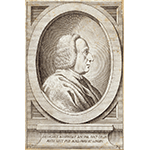Eustachio Manfredi
A mathematician and astronomer from Bologna, he was also active in the fields of poetry and philosophical questions. He studied at the Jesuit Monastery of S. Lucia and was awarded a degree in Civil and Canon Law in 1692. Under the guidance of Domenico Guglielmini (1655-1710) he devoted himself to the study of mathematics and hudraulics, while contemporaneously engaging in studies in astronomy. Appointed reader of Mathematics in 1699, he was called upon in 1704 to assume the positions of Superintendent of Waters in the territory of Bologna and Pro-Rector of the Montalto Papal Boarding School. The founder, along with Count Ferdinando Marsili, of the Observatory of the Bologna Institute of Sciences (1712), he studied the problem of the annual parallax of the fixed stars, the solution to which would have been the final proof of the correctness of the heliocentric model. Unfortunately, the complex treatise De annuis inerrantium stellarum aberrationibus (1729), containing the fruit of his long and accurate observations, was published too late, allowing the English astronomer James Bradley (1693-1762) to publish, some months in advance, the correct explanation of the phenomenon thanks to the discovery of the abberation of light from the stars. Undoubtedly conditioned by a cultural climate not yet ready to accept the new heliocentric theories, Manfredi showed great caution in his subsequent works, as demonstrated by some observations reported in the Istituzioni astronomiche [Astronomical institutions], a collection of his lessons in astronomy published posthumously in 1749. To Manfredi we also owe the series of the Bolognese Effemeridi [Journals], begun in 1715 and continued by his successors up to 1844. For his undenible merit in the literary and scientific fields, he was nominated member of the Accademia della Crusca (1702), of the Académie Royale des Sciences in Paris (1726) and of the Royal Society in London (1729).
Last update 30/gen/2008




